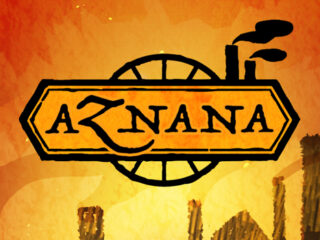Fun, Simple and Addictive
Slay is a turn-based strategy game created by Sean O’Connor. It has quite a long history with PC versions dating all the way back to 1997. It’s a lot of fun, and very addictive. The rules are simple enough to pick up in a few minutes and don’t require you to be a devout strategy aficionado, but there’s still enough depth to keep things interesting.
There are six sides on a map, each controlling several groups of hexes in their color. The more hexes you control, the more income you have, which you can use to buy peasants to convert more hexes to your control or clear away trees (which stop the hex they are on from producing income, and can spread to adjacent hexes if left unchecked) from existing territory.
 Each peasant, along with the capital hex of each group of adjacent controlled hexes, exerts a zone of control on all adjacent spaces in his side’s color, preventing enemy peasants from entering. To take hexes within this defense – and kill the peasant, if he’s standing on a hex adjacent to your territory- you need a spearman, made from combining two peasants. Breaching the zones of control of a spearman requires a knight made from three peasants, who in turn yields to a baron made from four. Units do not have a set movement speed – they can each take one action per turn, and they can take that action on any hex accessible from the friendly territory they’re in.
Each peasant, along with the capital hex of each group of adjacent controlled hexes, exerts a zone of control on all adjacent spaces in his side’s color, preventing enemy peasants from entering. To take hexes within this defense – and kill the peasant, if he’s standing on a hex adjacent to your territory- you need a spearman, made from combining two peasants. Breaching the zones of control of a spearman requires a knight made from three peasants, who in turn yields to a baron made from four. Units do not have a set movement speed – they can each take one action per turn, and they can take that action on any hex accessible from the friendly territory they’re in.
There are some interesting wrinkles. If you control multiple groups of hexes that aren’t connected to each other – as you do at the beginning of each map – they are treated as separate territories with separate finances, so that each of them pays maintenance costs for its own units and receives income only from its own territory. Thus, an important objective on each map is linking your separate territories together as quickly as possible to pool their resources, and defending the hexes joining them from the enemy – if two parts of a territory are cut off they become separate again, with each unit dependent on whichever territory they were in at the time for support. Taking hexes to solidify the connections between your territories and cutting enemy territories into smaller pieces is thus an essential part of your strategy.
Stronger unit types become geometrically more expensive to maintain – two credits per turn for a peasant, six for a spearman, 18 for a knight, 54 for a baron. You can’t disband or demote your units once created, and if a province finds itself with insufficient money to pay maintenance for its units because of territory and income lost to enemy invasion or a plague of unchecked tree growth, they all die. If you’re not careful, you can go from seeming dominance one turn to utter ruin the next because of the loss of a single hex that left too many of your units stranded in a territory unable to support them. This is a nice element to the game because it allows for sudden reversals in the course of the conflict without being in any way random or arbitrary.
It also requires the player to be thoughtful in their expansion. More units means more squares can be expanded into or cleared of trees each turn, and more advanced units make this easier to do in the face of enemy opposition, but also increases your risk by demanding more resources each turn to prevent disaster. Taking new hexes to expand your territory, especially at an enemy’s expense, is more appealing than clearing off trees from your own. But trees expand if left unchecked, choking off more and more of your income, and can be an even more overwhelming threat than the enemy if you don’t deal with them. I lost several early games  on what seemed like the brink of victory because I had been so busy crushing my enemies that I’d allowed trees to spread through my territory until they were too numerous to destroy before I ran out of money.
on what seemed like the brink of victory because I had been so busy crushing my enemies that I’d allowed trees to spread through my territory until they were too numerous to destroy before I ran out of money.
The graphics are rudimentary but in a game like this that’s largely irrelevant. What graphics the game has are serviceable enough- territory colors and unit types are easily differentiated, and the game has an appealingly bright and simple look to it. Sound is even more rudimentary – there’s a little fanfare that plays when you select or win a level and a few in-game sound effects, and that’s it. It does the job, however. (And I enjoyed the indignant shout of “Oi!” from enemy units when you try to make an illegal move into their zone of control.)
A more substantive problem is the touchscreen controls. Individual units and hexes are quite small, and a finger on a smart phone screen really doesn’t provide the precision needed – I spent quite a bit of time repeatedly tapping the screen to make my input register and or correcting moves that put my units on a square I didn’t intend because the game misinterpreted my input. It doesn’t ruin the game, but it can be quite frustrating; the game would probably benefit considerably from the use of a stylus.
All in all, though, Slay is definitely worth taking a look at. The gameplay is engaging and can be picked up almost immediately. There’s a large number of maps to play, with a variety of difficulty levels, so if you like the gameplay there’s enough of it to keep you occupied for quite some time. Its lack of audiovisual pizzazz doesn’t hurt it, given the nature of the game, and makes it readily accessible to people with a wide variety of phones. I played it on a smartphone running Android 2.2 and had no problems. I would gladly recommend Slay for anyone looking for a strategy game that can be played on the go.
Hardcore?
Yes.
Slay is a fun, simple, addictive game that’s easy to pick up and well worth playing for strategy fans.


























